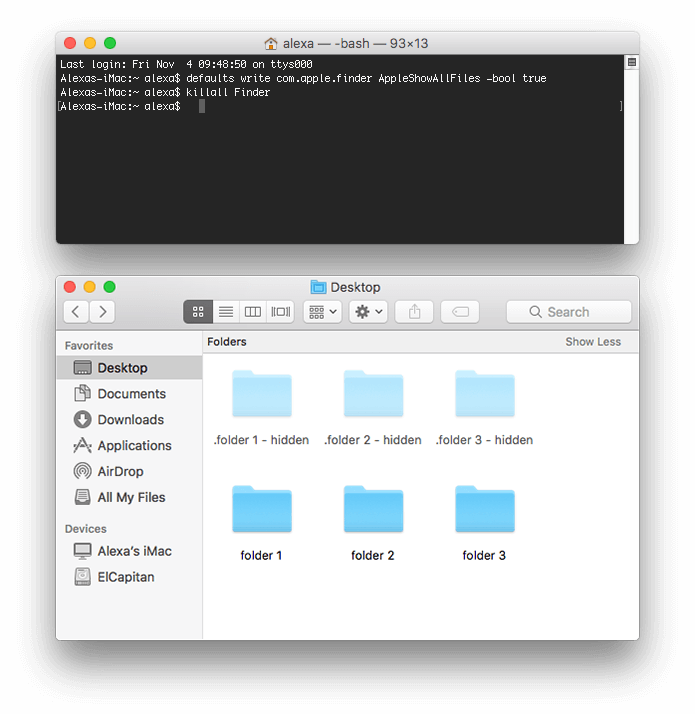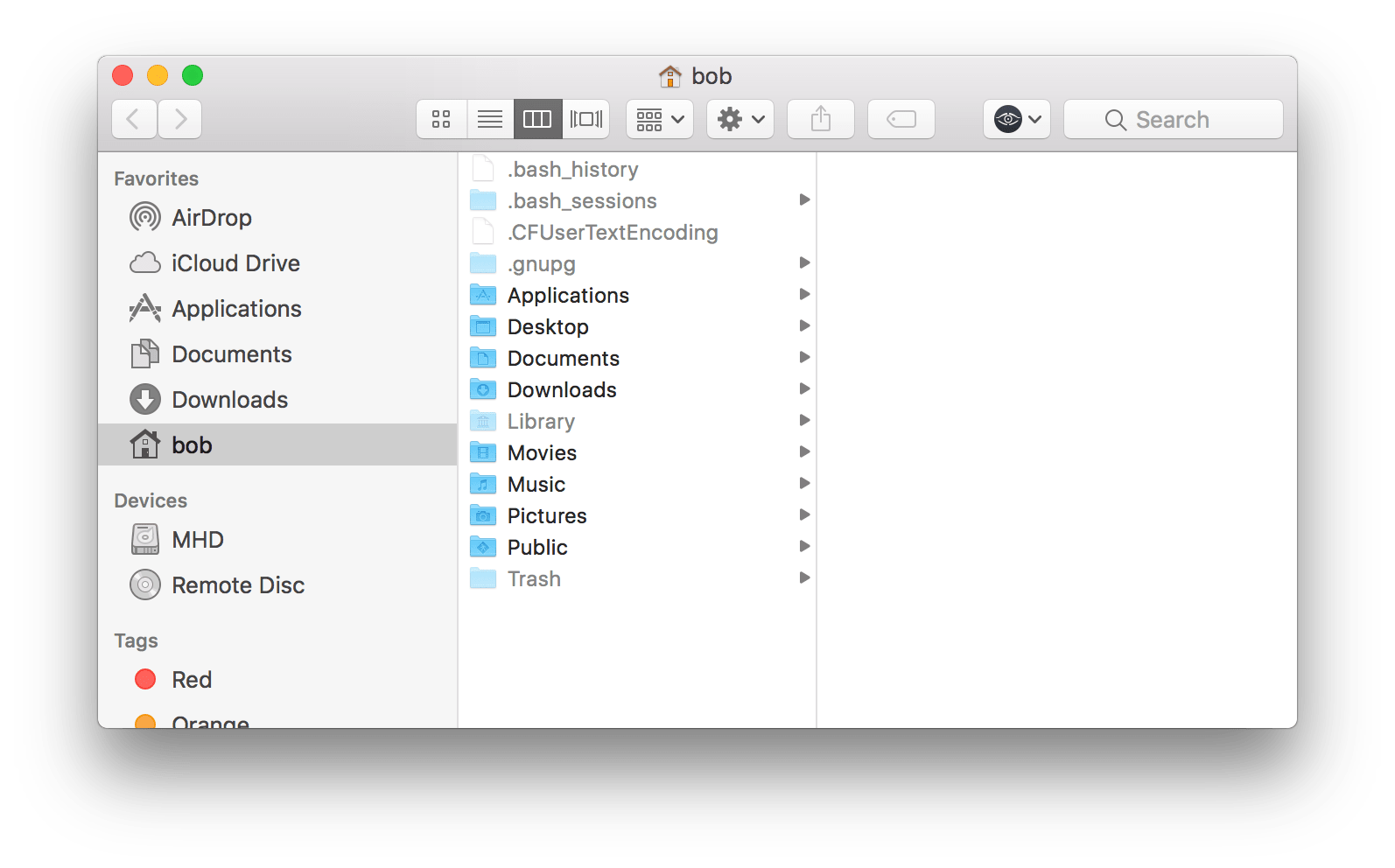Do you know how to show hidden files on Mac computers yet? Viewing them will help you to find out more information about the macOS operating system. Give us a minute to explain how to show and hide these important hidden files and folders!
View Hidden Files and Folders on Mac Using Terminal Terminal is the same command line tool for Mac users as Command Prompt is for Windows users. The Terminal tool that comes by default with MacOS is one of the most powerful using which you can do almost any task to control your Mac. Show Hidden Files for Mac is available as freeware with advertisements for other programs displayed initially, but these can be disabled or enabled easily from the main drop down menu. Viewing and hiding the system or default hidden files is easier in Mac as explained above. However, it is a tricky task to hide a users file or folder in Mac. Unlike Windows, you don't have any graphical interface to hide user files or folders in Mac.
Like other operating systems, macOS also keeps important files and folders hidden to prevent them from being deleted accidentally. The reason is that they perform some significant functions. It's hard to break something you can't see, isn't it?

Typically, the hidden files and folders in macOS that you won't be able to see by default will start with a dot, e.g., .htaccess file, .bash_profile, or .svn folder. The directories like /usr, /bin, /var, and /etc are hidden out of view, too.
- How to Hide & show hidden files Using Funter. There are some apps that allow you to use a hotkey for hiding or showing hidden files and folders on Mac, but we highly offer the Funter which is a free application to operate hidden files and folders.
- Thus, revealing hidden files is usually only necessary for more advanced Mac users, whether it's to view, edit, or modify some particular invisible file or folder, or contents therein. How to Show Hidden Files on Mac with a Keyboard Shortcut. Using the Show Hidden Files Keyboard Shortcut is incredibly simple, here's how it works.
Occasionally, in some cases, you may need to show hidden files on your Mac to fix a problem you are having, or to explore the Library folder and clear out old logs, caches, or other junk files.
Below, we have described three easy ways to show hidden files on a Mac.
Three Ways To Show Hidden Files On Mac Computer
One way is to use a keyboard shortcut, one is typing a line of command in Terminal, and the last is to execute an AppleScript.
Show Hidden Folder For Macbook
Let's dive in to find out how to show hidden files and folders on your Mac!
How To Show Hidden Files On Mac With Keyboard Shortcut
The quickest way to view all the hidden files and folders on your Mac is to use the Command + Shift + . keystroke. It's the same as tapping a toggle button that jumps between on and off state, respectively, to show and hide hidden files on Mac.
To make this work, open the Finder app and then press Command + Shift + . to show hidden files. Press this key combination again to hide them!

Unfortunately, this keyboard shortcut is only applicable if your Mac is running the Mac Sierra OS or above.
How To Show Hidden Files On Mac With Terminal Command
If you are more comfortable using the command-line app than the keyboard shortcut to show hidden files and folders, then follow this instruction:
1. Open the Spotlight search bar (Command + Spacebar) and type in: Terminal, then press the Enter key to launch the Terminal app.
2. Copy the following command, paste it into the Terminal app, and then press the Enter key.
3. Next, type in the 'killall Finder' command and press the Enter key to execute it. Otherwise, you can hold down the Option key, do a right-click on the Finder icon in the Dock, and then click the Relaunch option.
Both the 'killall' command and 'Relaunch' option will do one thing, to restart the Finder for the change to take effect. Once it's done, you will see hidden files and folders on your Mac.
To switch the files and folders back to hidden, repeat step number #2 and number #3, but change the 'YES' value in the command to 'NO'. The Terminal command should be:
Once it's done, the hidden files and folders on your Mac will become invisible again!
How To Show Hidden Files On Mac With AppleScript
What is AppleScript? Video converter ultimate free.
It's a scripting language that was created by Apple to automate repetitive or time-consuming macOS actions. It interacts primarily with apps and Finder to automate tasks for you. Whether it's a simple task like copying files or as complicated as building a real estate catalog, AppleScript can perform the necessary actions quickly and intelligently.
To make hidden files visible using AppleScript, press the Command + Spacebar to launch the Spotlight search bar, type in: Script Editor, and then press the Enter key to start the Script Editor tool.
Next step, you need to copy and paste the following script into the tool.
Lastly, click the Run button to execute the script.
Show Hidden Folder For Mac Osx

Typically, the hidden files and folders in macOS that you won't be able to see by default will start with a dot, e.g., .htaccess file, .bash_profile, or .svn folder. The directories like /usr, /bin, /var, and /etc are hidden out of view, too.
- How to Hide & show hidden files Using Funter. There are some apps that allow you to use a hotkey for hiding or showing hidden files and folders on Mac, but we highly offer the Funter which is a free application to operate hidden files and folders.
- Thus, revealing hidden files is usually only necessary for more advanced Mac users, whether it's to view, edit, or modify some particular invisible file or folder, or contents therein. How to Show Hidden Files on Mac with a Keyboard Shortcut. Using the Show Hidden Files Keyboard Shortcut is incredibly simple, here's how it works.
Occasionally, in some cases, you may need to show hidden files on your Mac to fix a problem you are having, or to explore the Library folder and clear out old logs, caches, or other junk files.
Below, we have described three easy ways to show hidden files on a Mac.
Three Ways To Show Hidden Files On Mac Computer
One way is to use a keyboard shortcut, one is typing a line of command in Terminal, and the last is to execute an AppleScript.
Show Hidden Folder For Macbook
Let's dive in to find out how to show hidden files and folders on your Mac!
How To Show Hidden Files On Mac With Keyboard Shortcut
The quickest way to view all the hidden files and folders on your Mac is to use the Command + Shift + . keystroke. It's the same as tapping a toggle button that jumps between on and off state, respectively, to show and hide hidden files on Mac.
To make this work, open the Finder app and then press Command + Shift + . to show hidden files. Press this key combination again to hide them!
Unfortunately, this keyboard shortcut is only applicable if your Mac is running the Mac Sierra OS or above.
How To Show Hidden Files On Mac With Terminal Command
If you are more comfortable using the command-line app than the keyboard shortcut to show hidden files and folders, then follow this instruction:
1. Open the Spotlight search bar (Command + Spacebar) and type in: Terminal, then press the Enter key to launch the Terminal app.
2. Copy the following command, paste it into the Terminal app, and then press the Enter key.
3. Next, type in the 'killall Finder' command and press the Enter key to execute it. Otherwise, you can hold down the Option key, do a right-click on the Finder icon in the Dock, and then click the Relaunch option.
Both the 'killall' command and 'Relaunch' option will do one thing, to restart the Finder for the change to take effect. Once it's done, you will see hidden files and folders on your Mac.
To switch the files and folders back to hidden, repeat step number #2 and number #3, but change the 'YES' value in the command to 'NO'. The Terminal command should be:
Once it's done, the hidden files and folders on your Mac will become invisible again!
How To Show Hidden Files On Mac With AppleScript
What is AppleScript? Video converter ultimate free.
It's a scripting language that was created by Apple to automate repetitive or time-consuming macOS actions. It interacts primarily with apps and Finder to automate tasks for you. Whether it's a simple task like copying files or as complicated as building a real estate catalog, AppleScript can perform the necessary actions quickly and intelligently.
To make hidden files visible using AppleScript, press the Command + Spacebar to launch the Spotlight search bar, type in: Script Editor, and then press the Enter key to start the Script Editor tool.
Next step, you need to copy and paste the following script into the tool.
Lastly, click the Run button to execute the script.
Show Hidden Folder For Mac Osx
Show My Files And Folders
A new dialog will show up to give you two options: Show Files and Hide Files. Choose the appropriate option to show or hide hidden files on your Mac computer.
Also, you can save this script as an app to use later! Every time you want to show or hide hidden files and folders, simply click on this saved app and pick the appropriate option.
Final Words
Important files and folders in macOS are typically hidden for a very good reason, namely to protect the operating system and its apps from the user accidentally meddling in a potentially catastrophic way. It's better to leave these files and folders alone unless you absolutely feel the need to make them visible.
How To Unhide Folders In Mac
The quickest and easiest way to show hidden files on the Mac is to hit the Command + Shift + . keystroke, but there are still other options you might like to consider, such as using Terminal or AppleScript. Generally speaking, if you aren't sure about things you are going to do, we suggest keeping them invisible to avoid accidental removal. When you have to do any meddling, make backups beforehand, just in case any data is lost.

